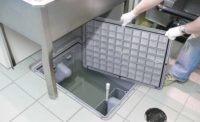Long-term trends, such as the progressive tightening of the Clean Water Act regulations and diminishment of funding for replacing/maintaining municipal collection systems, are putting a serious financial squeeze on the nation's sewer districts. As cities encounter increasing difficulty dealing with the cost of servicing food-processing facilities, there has been a correlated increase of mandatory pretreatment programs to coerce restaurants, hospitals, prisons, casinos, schools and other grease discharging sites to do a better job or pay for service costs incurred. Thus, a properly engineered drainage system which incorporates efficient pretreatment gets a free ride. But, to reach this point, it takes the talent and education of a plumbing engineer to evaluate contributing factors.
There are four major effluent sources affecting commercial foodservice kitchens involving grease and oils. First, the menu establishes the amount and types of nutrients to be washed off the cooking vessels and utensils. Fried chicken-type fast food restaurants wash a lot of cooking grease, flour and breading down the drain. Cafeterias wash large quantities of foodstuffs down the drain.
The greatest factor affecting effluent quality is the management and operating practices of a restaurant. The care given to scraping and cooking pans into a grease rendering collection vessel and the discarding of solids into waste containers is a major consideration. The emptying of high BOD (bio-chemical oxygen demand) waste, such as leftover milk products or beverages into proper waste containers, instead of down the drain, have a great effect on effluent nutrient concentration. They vary from day to day and restaurant to restaurant, even within chains. Because there is such variance, it is necessary for the system engineer to include control measures that:
- Automatically hold effluent discharge to a minimum, or
- Provide a greater degree of onsite sewage treatment system over capacity.
Contrary to popular conception, floor drains receive comparatively little waste. The entry points for the greatest amount of effluent nutrients are the multi-compartment pot wash sink and the pre-rinse sink at the dishwashing station.
The types of cooking and food production equipment used can also influence the amount and types of nutrient by-products entering drains. For example, fast food hamburger restaurants utilize griddles for cooking and fryers for french fries, apple pies and such. The utensils and fryer baskets are washed out in a three-compartment pot sink. The same is true of a chicken or pizza restaurant. Nearly 90% of all effluent nutrients, FOG and other foodstuffs pass into the three-compartment sink (75%) and pre-rinse sink (15%) at the time of dishwashing. No matter what changes might occur in the menu, if you can control what goes into the three-compartment sink and the pre-rinse sink, you will have control over the effluent quality.
Here's a design tip: To minimize FOG values, do not route the dishwasher discharge into a grease interceptor or automatic grease removal system. Dishwasher flows are rich in detergents and emulsify a high percentage of the separated fats held in a trap or separator. A sewer district sampling may show high level FOG, but visual inspection shows little free-floating grease in the trap.
Institutional and large commercial kitchens utilize a wide range of ware-washing and food preparation equipment. The increased number of grease-bearing point sources generally mandates centralized automatic grease removal systems. For example, an automatic 100-gpm system servicing a 300-bed hospital kitchen typically removes a 55-gallon barrel of grease every 7-10 days.
Another design tip: Rarely seen in full service kitchens, tilt kettles (used to cook large volumes of cooked meats, soups, sauces and other foods) are installed in more than 70% of institutional kitchens. These put large volumes of greases and foodstuffs into the drainage system. Kitchens in prisons, hospitals, and colleges frequently incorporate potato peelers, pulpers, wet hoods, bakery sinks, and other equipment that also can discharge large quantities of grease and foodstuffs. When specifying central removal systems for institutional kitchens, determine the maximum drainage flow value and provide at least 100 pounds (45 kg) of grease removal capacity per day.
A final tip: When selecting an automatic grease removal system, determine the peak flow volume. The GPD (gallons per day) figure is not as important as the peak flow value.
Pretreatment Systems: Understanding Grease Traps and Automatic Removal Systems
In the United States, the three predominant pretreatment systems for foodservice operations are small passive grease traps, large pre-cast concrete grease traps, and automatic grease/oil removal systems. Passive grease traps date back to 1885, when a U.S patent was issued. Today's large and small grease traps use the same basic operating design as the 1885 model. Grease and oils are 10 to 15% lighter than water and immediately float to the surface inside a grease separator, displacing water to the bottom and out of the separator. This is why you see a grease "mat" when observing a separator. Since grease and oil fill from the top down, it is frequently hard to measure the depth or fullness of the grease trap. The single most important aspect to understand is that, as a grease trap fills, its separation efficiency diminishes. When a trap is filled to capacity with retained grease/oils, there is no separation occurring in the flow stream. This creates a considerable volume of business for pipe cleaners.Optimizing Pretreatment for On-Site Systems
Effluent nutrient levels flowing to a septic field can be minimized and controlled by the following design and operation decisions:
- 1. Install a grease/oil interceptor at the primary point sources in the kitchen, i.e., the three-compartment sink and the pre-rinse sink. Have personnel empty system strainers and grease collectors every day.
2. Cease pouring nutrient-rich liquids down the drain (beer, milk, buttermilk, yogurt, etc.).
3. Avoid leaking detergent dispensers. Dishwashing detergent has a high BOD value.
4. For full service restaurants with high levels of flour, cornmeal and other particulate-type solids, install a 750-gallon pre-cast tank (or larger) to act as a suspended solids clarifier. Plumb outlet approximately 12" from tank bottom. Pump the clarifier when solids are 12" deep on the bottom.
It is indeed good news for restaurateurs that business is booming. But, the restaurant boom is taking its toll on the collection systems of the local sewer authorities. Fines and surcharges from these authorities are beginning to mount in areas that are strictly enforcing Clean Water Act regulations.
However, there is a growing trend towards aggressive engineering to confront these issues. Design engineers are becoming proactive by specifying innovative technology like automatic grease interceptors to help deal with this problem. By identifying and controlling the specific effluent sources in the kitchen, properly engineered drainage systems are controlling sticky situations caused by grease.
Types of Interceptors
Passive InterceptorPassive grease interceptors collect grease as it rises to the top of a baffled chamber when wastewater passes through the unit. Collected grease, however, must be removed by hand. A typical 20 gal/min (76 l/min) passive grease interceptor used by fast-food restaurants must be serviced at least once a week. When a passive grease interceptor is fully loaded with grease, it can default into a pass-through mode, allowing grease to flow through the unit and into the sewer. Separation efficiency is 95% to 98% when the unit is clean, but diminishes steadily as it fills with grease. New installation costs in a fast-food restaurant range from $1,000 to $1,500.
Pre-Cast Concrete Trap
A pre-cast concrete grease trap collects grease in the same fashion as a passive grease interceptor, only on a much larger scale. The most popular sizes are 750 to 2,000 gal (2.8 to 7.6 m3). The trap can store a larger quantity of grease than a passive interceptor; however, it is expensive to install and maintain. Users must pay a pumping company to clean the trap periodically (once a month, on average). Otherwise, grease will emulsify and flow into the sewer line. Installing a grease trap in a fast-food restaurant undergoing construction typically costs $2,500 to $4,000; installation in an existing restaurant may cost as much as $25,000.
Automatic Interceptors
Automatic interceptors collect grease in a baffled chamber as wastewater flows through the unit. Collected grease is removed automatically at predetermined times. These units remove up to 98% of effluent grease. Unlike a concrete grease trap, automatic units are much smaller-some can fit beneath a typical counter. Self-cleaning is accomplished by heating the trapped grease mat, transforming grease into a liquid (110? to 120?F) that is removed by skimming or an automatic draw-off. Because grease is automatically removed several times a day, emulsified grease emissions can be reduced significantly. The cost of installing an automatic interceptor in a new restaurant is $3,500 to $4,500. The units also have an operating cost of about $90 per year.


